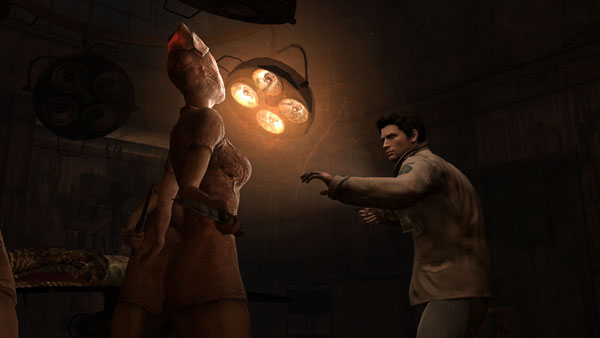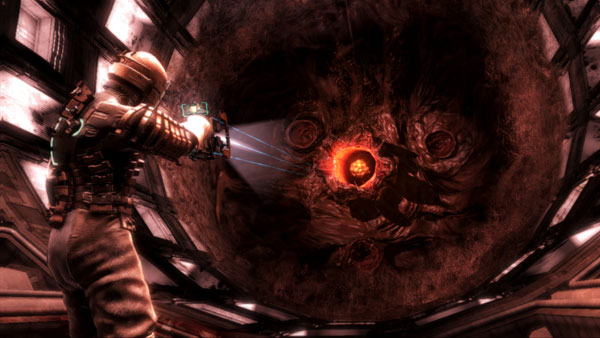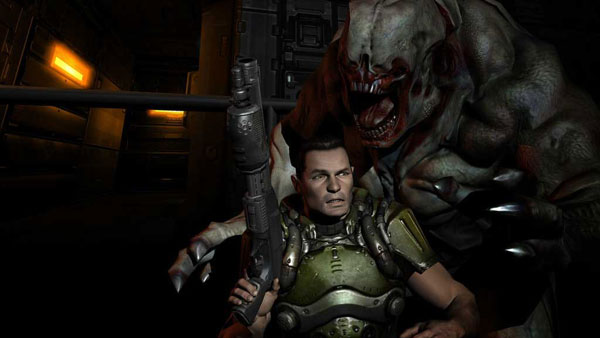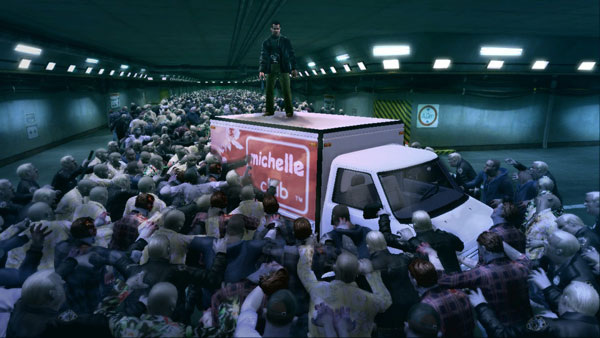As soon as I flip my calendar from September to October I find myself watching movies and playing games that are zombie and horror themed. I can?t help myself. When I was younger, my favorite annual television event was some station?s ?Shocktober?: they would play a scary movie every night of the month and every year it would be the same movies and I would watch them again and again. It wasn?t until years later that games started to provide the kind of scares that I used to get from movies, and now playing a few scary games is essential to a proper October.
Horror video games are certainly an interesting bunch. They borrow almost everything from film, but their interactivity allows for new ways to immerse the player. Resident Evil and Alone in the Dark, the two titles which kick-started the horror genre for video games, used a film-like camera and presented a montage of static camera shots. More powerful hardware and more daring developers led to the standard of a non-fixed third-person camera and the proliferation of first-person shooting games make the subjective camera a viable option as well. In horror films like The Blair Witch Project the subjective camera shot works extremely well, but unlike in video games, it fails when overused.
Another unique aspect of video games is the game over screen. This vestige of arcade games allows developers to make the threat of the protagonist?s death all the more present to the players. With the original Resident Evil players would be sent back to the last typewriter they recorded their progress at, but more recently games have been opting to use this penalty less, and focus on other aspect to immerse the player. Resident Evil 4 for instance, simply sends the player back to the last of frequent checkpoints.
Darkness is one of the most important aspects of the horror genre in both film and video games. Unknown dangers lurk in the shadows, so the shadows themselves become the primary threat to the protagonist. Unlike film, video games allow the player to confront the shadows, and any threats it might spawn. In a third-person camera view, the player will ?lock-on? to an enemy, and in a first-person view, the player uses his gaze as the weapon. This conflict allows the player to become a more active participant in the story.
Since the player is in control of these encounters, to increase their suspense, the player character is often extremely vulnerable. Limited ammo, healing items, and space to carry these items are often considered the trademark aspects of the horror video game genre. When not in direct conflict, the player is reminded of the possibility that he will not survive the next encounter unless he finds some more ammo first. This is an idea borrowed from film, but because of the dynamic nature of video games, the player is less sure of the outcome.
The major aspect in which video games fall grossly behind film is transparency, for many reasons. The first and obvious is technical limitations. While film is using live actors supplemented with pre-rendered digital effects, they can appear much more natural than video games, which are dynamically created from digital content. Video games also have to give players much more explicit information than movies, so using simple cues is more difficult, and developers often resort to using a heads up display. Additionally video games tend to have a much smaller acting budget and the cutscenes are ersatz films with bad lip-syncing, animation, and voice acting. This sense of transparency, that what you are seeing is real, is where film excels and video games just can?t compare to despite rapid increases in computing power and video game budgets.
This year, I was especially seasonal in my media intake. I watched several zombie movies, caught a few splatter horror movies on television, and have been playing Silent Hill: Homecoming, Dead Space, Doom 3: Resurrection of Evil, and Dead Rising. These four games are an interesting bunch to compare because each has a significantly different approach to the horror genre. Some build on the old standards, some revisit them, and some throw everything out the window.
Silent Hill: Homecoming is the most traditional of the games I played. Like the games that started the genre, it is trying to present itself as a film. The most telling sign is the film grain that is always visible. While the HUD is only present when necessary, such as prompting them to interact, the film grain always separates the player from scene. Thus the goal is not to convince the player that they are the protagonist, but that they are watching a film. It?s a bit surprising then that the game uses a dynamic third-person camera instead of a more filmic static camera, and was probably chosen only because it?s an easier solution.

While playing Homecoming I began to feel extraneous. Although the game kept insisting my participation is necessary with the occasional push of the ?a? button, I wasn?t convinced that I would have experienced the game any differently if it were all a cutscene. The exception is the combat. Because the game uses three of the face buttons to create a simple fighting system of light attack, strong attack, dodge, I can do well and make sure the protagonist continues unharmed. I suppose I was a little too good at this fighting system though because the protagonist was unstoppable under my control.
Fog is a staple of the Silent Hill series and it replaces what would traditionally be darkness. While you don?t have a tool that allows you to see deeper into the fog, you can see ahead by moving. Video games will often have the player character emit a small amount of light so that even in darkness the immediate area can be seen, and fog reproduces this effect. It makes controlling the character more interesting and adds to a sense of exploration, but it isn?t enough to prevent a cinematic feeling of linearity that plagues Homecoming.
The benefit of having such a linear and filmic game is that you can create a psychological horror. The player can grow attached to characters and become engrossed in the story as he helps it to unfold. The problem is that the content is generally not going to be as interesting as it would be in a movie since the narrative interest is broken up by long periods of bland exploration, so I hope I won?t be blamed for not sticking with it long enough to advance the story.
Dead Space is an innovative attempt to revisit some of the problems of traditional horror games. Rather than creating a more character-rich psychological horror, the game goes for the more gamey suspense horror. The interactive nature of video games makes it much easier to put the player into a scary environment, rather than trying to present interesting and meaningful characters he can relate to, so this seems like a more natural way to approach horror in a video game. Dead Space also takes all explicit HUD elements and makes them a part of the fictional world so that they do not stand between the player and the game world. Even the inventory screen is seen as a projected hologram that the player character is managing. This allows the game to be more film like in the way it ignores the player/viewer and to increase the suspension of disbelief.

While shying away from certain elements that video games do not excel at, Dead Space is still not trying to ignore film altogether. The third-person camera is evidence. If the developers wanted to truly immerse the player into the game world, a subjective camera view would have been more appropriate, but instead we are definitely asked to identify with an on-screen character. To increase this identification, the developers tried to create a suit for the character that made sense as a simple engineering outfit.
The game is not very dark and you won?t have creatures popping out of shadows. Instead there is a system of vents that runs throughout the game world and the enemies can travel through these vents to pop out near the player character to attack. Thus the entire ship becomes the enemy that the player fears and must also obey (the objectives are usually to activate something on the ship).
Another benefit of the in-game inventory management screen is that your player character is vulnerable while doing menial inventory tasks. In most horror games, managing the inventory causes the game to pause which pulls the player out of the game world. The in-game inventory management system keeps the player immersed consistently throughout the game.
The setting of the game does much to help immerse the player as well. There are some settings that dynamically rendered digital video can do very well (indoors, shiny metal, hard geometry), and some that it does not do very well (organic textures, smooth geometry). Dead Space is almost entirely the former, and in what seems a bit of an accident, the enemies are nearly the only evidence of the latter. The enemies would probably be much more convincing if they were, as the player character is, shrouded in Euclidean geometry.
The haunted space station theme certainly isn?t only used because it?s easy for computers to render the setting, or because the loneliness of space complements the solitude of playing video games. As Event Horizon, and the film Doom showed, outer space is simply good for scares.

If there?s a game a like to champion because I feel like it?s an undervalued gem, it is Doom 3. I think many players were a bit baffled by the game because games like Halo really changed the ways shooters were played and added a lot of depth to the combat. Doom 3 opted to go a different route and provide very simple combat with suspense and immersion. One major flaw with the maintenance of suspense was the ?monster closets?. Sometimes walking by an area would cause a hidden door to open with a monster inside waiting to pounce. It seems they were trying to emulate the jumpy scares of horror movies, but the shame is that an imp encounter is much scarier if you see his shadow coming around the corner, or hear his claws scratching on the wall first. In Doom, it?s the anticipation that will get you.
It wasn?t until I build a new computer capable of rendering Doom 3 at 60+ frames per second with ?ultra high? quality textures and full anti-aliasing that I got around to trying the expansion pack/sequel: Doom 3: Resurrection of Evil. When I talk about Doom 3, I?m usually referring to this expansion pack because it?s more or less the same game, but with two improvements: there are fewer monster closets, and there is an item that allows you to slow down time. The irony of the latter improvement is that it makes the game better by reducing some tension. I can only play Doom 3 for under an hour in the dark with headphones on before I just get too tense, but having the ability to slow-down time to make encounters much more safe has a calming effect, that surprisingly helps me enjoy the game.
The suspense of Doom 3 is all based on the threat of the shadows. The lights often turn off, sometimes red emergency lights are the only source of light. The source of the greatest suspense in the anxiety comes from the use of the flashlight. The player will often have to navigate completely darkened corridors using the flashlight, but if the flashlight is being used, the player is not weapons ready. By using the flashlight, however, the player turns the shadows into monsters, and then must fumble with the keyboard keys to equip the proper weapon to fight with. The darkness is the source of all the tension, but by dispelling it, you are creating another kind of tension.
Doom 3 is often ignored as a horror game, as if it being a first-person shooter and a horror game were mutually exclusive (for more, check out F.E.A.R., which unfortunately I haven?t played enough of yet to really comment on). Part of the reason for this is because the game provides the player with plenty of ammo, no inventory system, and a quick-save system, the threat of death is meaningless. While the threat of ?game over? is obviously not the only or even the most potent source of suspense, the game does try to keep this fear alive by only providing health at health stations. There is no way to regenerate your health level without finding a medical station.
Because Doom 3 uses a subjective camera view, the player has no player character to identify with and is much more readily projected into the world of the game. If the goal of the game is to present the player as a character, rather than to give the player control of a character with an autonomous personality, the first-person camera is a much better choice. The use of shadow for suspense, and the first-person view make this a terrifying game. While most games are rated as being fun or not, it?s hard to call Doom 3 fun when it?s so taxing, but it?s certainly exciting and scary. I?m sure I?ll keep going back to this game every October for the next few years at least.
One of the major reasons I?d never consider myself a horror buff is that I am not terribly interested in campy horror, which is a major staple of the genre in film. Since video games are plagued by the kind of bad (voice) acting that turns movies into cult classics, campy horror seems like the perfect fit for a video game. Dead Rising stepped up to the plate, and delivered a little too successfully…

The game has the appeal of a bad zombie movie: corny dialogue, one-dimensional characters, and gore. But the game is campy both as film and video game: it uses many “bad” video game elements. The computer controlled characters you have to escort are terribly stupid, the bosses soak up too many bullets, the save system is some sort of mish-mash of save points and auto-save the latter of which cannot be counted on, there is the nagging phone ring that is reminiscent of the low health buzzer from Zelda.
Dead Rising certainly isn’t the first to do video game camp. D3′s Simple Series games are probably the best example, but Dead Rising takes the prospect of a campy video game much further, and more importantly, the game is more inviting to play. The core game mechanic of “grab anything, kill everything” is exceptionally sound and is much more advanced than the more simple combat system of D3′s Onechanbara for example.
I tend to describe playing Dead Rising as “putting up with” its faults to enjoy the zombie-bashing, but perhaps I am too used to the status quo of video games furthering transparency of the medium. This certainly was one of the more interesting games I’ve been playing the last few years (I think I made four failed attempts before finally completing the main storyline), but could that final boss battle have been less obnoxious but still campy? Certainly.
Well, now it’s on to the less gruesome of the holidays in the holiday season. I guess it’s time to start thinking about Christmas NiGHTS.
